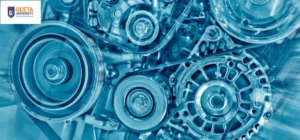Robotics Impact on the Future: Revolutionizing Industries
UncategorizedRobotics Impact on the Future: Revolutionizing Industries
- August 3, 2024
- Geeta University
Robotics stands out as a transformative force in the ever-changing face of technology, with the potential to alter industries all over the world. This might be a game-changer for many different countries. The use of robotics has already started to transform the way that we work and live in a variety of industries, ranging from manufacturing and healthcare to agriculture and beyond. As we progress deeper into the complex realm of robotics, it becomes increasingly clear that these intelligent machines are more than just instruments; rather, they are the designers of a brand new era. In this piece, we will investigate the current status of robotics and its far-reaching ramifications, while also imagining a future in which robots play a vital part in determining the course of many industries.
The Current State of the Situation:
The history of robotics began with simple machines that performed repetitive tasks on assembly lines. Fast-forwarding to the present, we find ourselves in an era where artificial intelligence, machine learning, and sophisticated sensors have been incorporated into robotics, pushing the technology beyond its initial limitations and producing a new generation of robots that are capable of learning, adapting to their environment, and interacting with it in ways that were previously thought to be the domain of science fiction.
Manufacturing Industry:
One of the most notable industries that robotics has had a significant impact on is manufacturing. Robots have become an indispensable part of production line automation, which has led to increased productivity and improved accuracy in the manufacturing of goods. Since the introduction of collaborative robots, or cobots, the line between human and machine interaction on factory floors has blurred even further. Cobots like these enhance the capabilities of human workers and help streamline workflows while working side by side with them. The fact that humans and robots can collaborate in manufacturing is not only a glimpse of the future; rather, it is evidence that smart factories are already a reality today.
Health care:
In the medical field, robotics is making significant strides that are revolutionizing patient care, surgical procedures, and rehabilitation. For example, surgical robots are becoming more commonplace in operating rooms, providing an unparalleled level of precision and reducing recovery times. Additionally, hospitals are using robots to perform routine tasks, freeing up human workers to focus on more complex aspects of patient care. Finally, as the elderly population ages, more and more will require companionship, assistance, and monitoring—tasks that robots can handle.
Agricultural Methods:
Robots in agriculture are helping farmers meet the challenge of feeding a growing global population. Robots equipped with sensors and cameras can autonomously roam fields, identify crops, and perform a range of tasks like planting, harvesting, and weeding. This not only increases productivity but also lowers the amount of pesticides needed and the overall environmental impact. Robotics and agriculture together have the potential to develop environmentally friendly farming practices that can meet the demands of feeding a growing global population.
The Challenges and Ethical Issues Ahead of Us:
While there is no denying the benefits of robotics, there will be challenges to overcome and moral dilemmas to resolve in the near future. The fear that workers would lose their jobs due to automation is legitimate, and legislators and business leaders should strive to strike a balance between the advancement of technology and worker welfare. Additionally, the ethical implications of autonomous machines raise issues related to responsibility, openness, and potentially inappropriate use of technology. As we move forward in this new area, it is essential that moral frameworks be established to direct the development and application of robotic systems.
The Way That Remains:
The direction that robotics is currently taking seems to point toward a future where intelligent robots will become more and more integrated into our daily lives. These robots will have an impact on a wide range of industries, including smart homes, transportation, education, and entertainment. The convergence of robotics and artificial intelligence is bringing in a new era where computers will be able to do more than just perform tasks; they will also be able to understand, learn from, and adapt to the nuances of human experience.
Storage and Supply Chain Administration:
A paradigm shift has occurred in the logistics and warehousing sector of the economy as a result of the introduction of robotics. Autonomous mobile robots, or AMRs, are finding their way into large warehouses where they are streamlining order fulfillment and enhancing inventory management. When combined with human workers, these robots increase productivity while reducing the possibility of errors. Drones equipped with cameras and other sensors are also being used for inventory tracking in large storage facilities. Robotics in logistics offers improved customer satisfaction and shorter delivery times as the e-commerce sector continues to experience rapid growth.
Building:
The construction industry, which has always been known for its labor-intensive work, is currently experiencing a revolution due to the introduction of robotics. Robots that are skilled in tasks like welding, bricklaying, and concrete pouring can greatly speed up the construction process. Drones equipped with various surveying instruments and sensors can perform site inspections and mapping more precisely and safely. Robotic exoskeletons reduce the risk of injury and ease the strain on workers’ bodies. The end result is a safer and more efficient construction environment.
3. Accounting and Customer Service Provision:
In the financial sector, robotics is being used to automate labor-intensive tasks that were previously labor-intensive, such as data entry, transaction processing, and consumer inquiries. Artificial intelligence-driven chatbots and virtual assistants, driven by natural language processing, are now handling common customer support inquiries, freeing up human agents to focus on more complex problems. The financial industry is adopting robotics not only to increase productivity but also to provide clients with more personalized and responsive services.
4. Advice:
The educational landscape is changing to make room for robotics, which will improve the learning experience for students. Educational robots are becoming more and more common as a means of teaching students coding, programming, and other STEM subjects in an interactive and hands-on way. These robots not only impart technical knowledge but also foster creativity and problem-solving skills in their users. Telepresence robots enable students to attend classes remotely, opening up the possibility of distant learning for higher education institutions. The growing need for workers with digital skills has made robotics a crucial part of the process of preparing the workforce of the future.
5. Providing Entertainment and Welcome:
Robots are being used in the entertainment industry to create more immersive and engaging experiences. Automated characters that can mimic human movements and facial expressions are commonly seen in theme parks. Robots are also being used in the hospitality sector to perform a range of tasks, such as housekeeping, room service delivery, and concierge services. The use of robots in these sectors not only increases efficiency but also infuses a new and innovative element into a company’s interaction with its clientele.
6. Monitoring the surroundings:
Robots play a vital role in the process of monitoring and protecting the environment. Autonomous underwater vehicles (AUVs) and drones equipped with sensors are used to collect data about the condition of the ocean, the amount of pollution, and the movements of marine species. Land-based robots monitor the spread of deforestation, track the movements of endangered animals, and support reforestation efforts. Robots have proven to be an incredibly useful tool in protecting the planet’s biodiversity and finding solutions to environmental problems because of their ability to operate in difficult-to-reach environments.
Considering the Future:
The integration of artificial intelligence, machine learning, and advanced robotics is reshaping industries in ways that were previously unthinkable, and as we navigate the complex terrain of robots, it is becoming more and more evident that we are at the beginning of a revolutionary period. New developments and emerging trends include the following:
1. Combining machine learning with artificial intelligence:
The future of robotics will depend on the smooth integration of machine learning (ML) and artificial intelligence (AI). As these technologies advance, robots will be able to learn and adapt in real time in addition to performing pre-established tasks. This progress toward cognitive robotics holds great promise for the creation of machines that can solve complex problems, make decisions, and work independently in ever-changing environments. Such machines will be necessary for industries and fields where flexibility and problem-solving abilities are critical.
2. Humans and Robots Working Together:
A more profound form of collaboration than mere coexistence is emerging in the workplace; in the not too distant future, robotic systems will be designed to operate more naturally alongside humans, perceiving and reacting to human gestures, words, and emotions. This approach to collaboration maximizes the capabilities of both humans and robots, forming a synergistic relationship in which each entity’s skills complement the other’s. The net effect is a workforce that is more flexible, productive, and leverages the unique advantages that both organizations possess.
The Sensitivity of Automated Groups:
Swarm robotics was inspired by the cooperative behaviors of natural swarms and involves organizing large groups of robots to perform tasks cooperatively. This approach shows a lot of promise in scenarios where multiple robots can work together to accomplish challenging tasks; missions like environmental monitoring, infrastructure inspection, and search and rescue are just a few examples of potential applications. Robotic swarms are particularly well-suited for complex and dynamic environments because they can assign tasks to each other and adapt their behavior to changing conditions.
4. Robots with soft material interfaces:
The traditional robotics approach often uses rigid structures and systems, but a new field of robotics called soft robotics is developing with the aim of replicating the flexibility and adaptability of living things. Soft robots are made of materials like elastomers and polymers, and because of their shape-changing capabilities, they can adapt to their environment and become part of the work environment. This makes them ideal for jobs that take place in unpredictable chaotic environments, like medical operations, where the delicate nature of soft tissues requires a softer touch. The development of soft robotics opens up new possibilities for human-robot interaction and cooperation.
Robotic Space Exploration:
As humanity continues its exploration of space, robotics will play a bigger role in human endeavors. From exploring other planets to conducting experiments to even laying the groundwork for potential human settlement, autonomous rovers, drones, and robotic arms will be used in many different capacities. Robots have become indispensable allies in our quest for a better understanding of space because they can operate in harsh environments where human presence would be difficult or impossible.
The Social Consequences:
1. The Need for New Skills and the Evolution of Jobs:
Because of the widespread deployment of robotics, the labor market will undoubtedly undergo significant change. New roles requiring uniquely human qualities like creativity, critical thinking, and emotional intelligence will emerge, while some mundane work may become automated. Individuals will need to prioritize lifelong learning and skill acquisition in order to be able to adapt to the constantly changing demands of the labor field.
2. Measures Taken to Lower Inequality:
As automation and artificial intelligence become more pervasive, the need to eliminate socioeconomic disparities will only increase. People must have access to education and training programs that can equip them with the skills they need to succeed in the digital age. Politicians and business executives will also have a lot of work ahead of them to do to ensure that the advantages of technological advancements are distributed equitably.
The following are recent advancements and new trends:
3. Combining Machine Learning with Artificial Intelligence:
The future of robotics will depend on the smooth integration of machine learning (ML) and artificial intelligence (AI). As these technologies advance, robots will be able to learn and adapt in real time in addition to performing pre-established tasks. This progress toward cognitive robotics holds great promise for the creation of machines that can solve complex problems, make decisions, and work independently in ever-changing environments. Such machines will be necessary for industries and fields where flexibility and problem-solving abilities are critical.
4. Humans and Robots Working Together:
A more profound form of collaboration than mere cohabitation is emerging in the workplace; in the not too distant future, robotic systems will be designed to operate more naturally alongside humans, perceiving and reacting to human gestures, words, and emotions. This cooperative approach maximizes the capabilities of both humans and robots, forming a synergistic relationship where the abilities of each entity complement each other. The net effect is a workforce that is more flexible, productive, and leverages the unique advantages that both organizations possess.
5. The Robotic Swarms’ Intelligence:
Swarm robotics was inspired by the cooperative behaviors of natural swarms and involves organizing large groups of robots to perform tasks cooperatively. This approach shows a lot of promise in scenarios where multiple robots can work together to accomplish challenging tasks; missions like environmental monitoring, infrastructure inspection, and search and rescue are just a few examples of potential applications. Robotic swarms are particularly well-suited for complex and dynamic environments because they can assign tasks to each other and adapt their behavior to changing conditions.
6. Robots using soft materials interface:
The traditional robotics approach often uses rigid structures and systems, but a new field of robotics called soft robotics is developing with the aim of replicating the flexibility and adaptability of living things. Soft robots are made of materials like elastomers and polymers, and because of their shape-changing capabilities, they can adapt to their environment and become part of the work environment. This makes them ideal for jobs that take place in unpredictable chaotic environments, like medical operations, where the delicate nature of soft tissues requires a softer touch. The development of soft robotics opens up new possibilities for human-robot interaction and cooperation.
7. Robot-Assisted Space Exploration:
As humanity continues its exploration of space, robotics will play a bigger role in human endeavors. From exploring other planets to conducting experiments to even laying the groundwork for potential human settlement, autonomous rovers, drones, and robotic arms will be used in many different capacities. Robots have become indispensable allies in our quest for a better understanding of space because they can operate in harsh environments where human presence would be difficult or impossible.
The Social Consequences:
1. The Need for New Skills and the Evolution of Jobs:
Because of the widespread deployment of robotics, the labor market will undoubtedly undergo significant change. New roles requiring uniquely human qualities like creativity, critical thinking, and emotional intelligence will emerge, while some mundane work may become automated. Individuals will need to prioritize lifelong learning and skill acquisition in order to be able to adapt to the constantly changing demands of the labor field.
2. Measures Taken to Lower Inequality:
As automation and artificial intelligence become more pervasive, the need to eliminate socioeconomic disparities will only increase. People must have access to education and training programs that can equip them with the skills they need to succeed in the digital age. Politicians and business executives will also have a lot of work ahead of them to do to ensure that the advantages of technological advancements are distributed equitably.
3. Ethical Conduct and Regulatory Compliance Frameworks:
Ensuring that clear regulations and guidelines are established is crucial to preventing the exploitation of technology and guaranteeing that advancements in robotics are in line with social values. Sturdy frameworks will be required to address the various ethical concerns that are raised by robotics, such as bias, privacy, and accountability.
4. Sustainability and Environmental Impact:
Robotics has the potential to significantly improve environmental conservation by increasing resource efficiency and reducing material waste. However, there is still much work to be done to ensure that robotic systems are manufactured, used, and eventually disposed of in an environmentally responsible manner. First steps in this direction include designing robots with sustainability in mind from the outset and implementing recycling programs for old machinery.
Final thoughts:
As we navigate the rapidly evolving field of robotics, there is a great deal of potential for good. Robots are quickly emerging as essential collaborators in many facets of our lives, from the reorganization of industries and the improvement of productivity to the resolution of complex problems in the fields of healthcare, agriculture, and other industries. However, this revolutionary potential also carries with it the responsibility of managing the ethical, societal, and economic ramifications of a world where intelligent computers are becoming more and more integrated into daily life.

Admission Open 2024-2025
For Your bright Future
Tags
Related Posts

How to find the correct stream after the 10th standard? – Geeta University
Are you confused about which stream to choose after 10th? What is the best stream of the future? What should you learn after Class 10th? Almost all students sails in the same boat. These are the top questions asked by

Best Courses After 12th Science, Future, Scope and Career Prospects – Geeta University
One question that keeps popping up in the minds of all 12th grade students is how to choose a safe, secure and fruitful career option. The task of choosing the right path can be difficult for Grade 12th students specially

Best Courses After 12th Arts, Future, Scope and Career Prospects – Geeta University
It is important to choose the right subject for your graduation because it is probably the most important time for your study. Making the right decision today will put you on the path to school and professional success by enrolling
